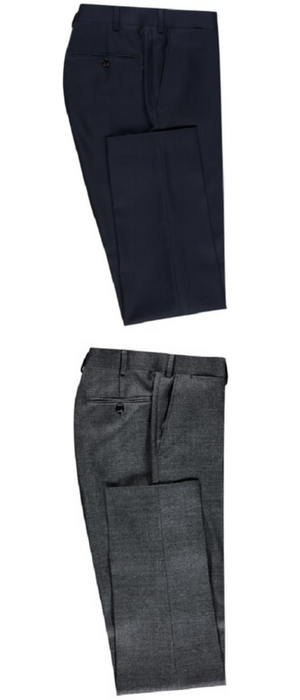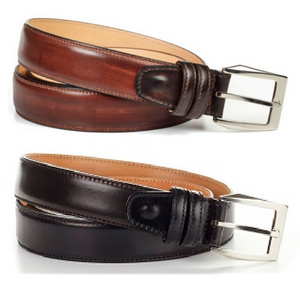Phase 2 — Developing Your Gentleman Spy Style
Lesson 3 — The Suits
LESSON 3: The Suits

007 is the suited warrior. A hard man in a good fitting jacket.
The suit is the pinnacle of a man’s wardrobe, and as such, needs to be chosen carefully.
With tons of styles to choose from, it’s easy to get overwhelmed, so keep things simple:
- Suit color, before fit and style, is what everybody will notice first. Stick with gray, blue, and black. Blue means navy blue or darker, never lighter. Solid colors are the way to go at first. Once you have solid color suits in the primary colors, then you can add pinstripes, lighter colors (cream/beige/light gray), or other patterns as you wish.
- After color comes material. Wool or cotton, and their siblings, are the only acceptable options here. To simplify even more, Super 100s through Super 160s are good. Anything lighter is too flimsy and won’t hold up, anything heavier is too coarse.

Jacket
Single breasted. Two or three buttons. Notched lapel.
It should fit close to the body, but not wrinkle when buttoned. Pockets should be straight with flaps; leave the diagonal pockets to the Italians. Double vents in the back – no vent will restrict your movement, and a single vent neither looks as good, or moves as well as double. The sleeves should be tailored so that ¼ to ½ inch of your shirt sleeve shows while your arms are hanging at your side.
To truly complete the Bond look, you want functioning button holes at the cuffs, but you often have to get a fully bespoke suit to make that happen while maintaining proper fit, so don’t put off getting “good enough” waiting to be able to afford something from Tom Ford, Brioni, or Savile Row.
A word on wearing the jacket: if you’re standing, moving, etc. it should remain buttoned. Only undo the button while sitting. On a two-button suit, only the top button gets buttoned. On a three-button suit, only the middle gets buttoned.

Trousers
While traditional men's style rules allow more room here, for the Gentleman Spy, the choice is easy: flat front, straight cut, no cuffs.
You can go a little lower-rise if you have a very athletic physique, but don't try to wear them like low-cut jeans – trousers are supposed to fit at or just below your waist. Turn-ups (cuffs) are okay for older, or tall men, otherwise, it's best to leave them straight. As a general rule, stay away from pleated trousers: flat front pants will always be stylish, but pleats have fallen largely out of fashion and will make you look old, stodgy, and heftier.
There’s some leeway in the fit of the pants, but always ask yourself, “will I look good in these pants without the jacket?” If so, you’re good to go; if not, get them tailored.
Pants will usually come un-hemmed, so you’ll need to have a tailor at least adjust the length for you. They should fall straight to the heel of the shoe in the back, with one break at the front.

Dress Shirt
Ian Fleming’s Bond wore a midnight blue suit with a crisp, white, Sea Island cotton dress shirt underneath. Whether or not you spring for the Sea Island cotton, looking like 007 requires more than a trip to the local department store these days.
First up is the basic fit — the neck and the arm length must both fit. The neck should be snug, neither restricting or loose, and the sleeves should come to the end of the wrist. Find your dress shirt size by measuring your neck and arm length. Your neck is measured just below the Adam’s apple, and you should be able to comfortably fit two fingers between your neck and the measuring tape. Sleeve length is measured with your hand on your hip, your elbow bent at 90 degrees. Measure from the back of the neck, along the shoulder and elbow, to the wrist.
Once you know your size, options are available in collar and cuff design, but there are some rules you need to adhere to.
Collar: opt for medium, spread, or tabbed collars. Avoid button-down collars; they are too American, too informal, and in some circles too "low class" to complete the Gentleman Spy look.
Cuffs: Bond prefers double (French) cuffs and silver cufflinks, and for a formal event, these can’t be beat. Own at least one crisp, white, clean dress shirt with double cuffs. For daily wear, however, this might be overdoing it. If you’re confident rocking double cuffs all the time, then go for it, but most men aren’t, and would be better served by a barrel cuff (“normal” button cuff) for general wear.
Pockets: for the cleanest, classic style that looks as good with your jacket off as it does with it on, stick with flat front shirts with no pockets.
Color: white and light blue are the staples that every man should have. You can branch out into light pink, lavender, gold, French blue, off-white, and more if you want, but you would be perfectly suited with nothing but a few white and light blue dress shirts.
Pattern: solid will always be the most formal and most versatile. Stripes are a good choice once you have a few solids. Checks are the least formal; fine for casual occasions, but they don't exactly exude the Gentleman Spy style.
You will need to have the shirt tailored to your body shape, not left blowing in the wind with the excess fabric common to off the rack sizes. The good news is that custom shirting is more accessible than ever, with great options available everywhere form brick and mortar stores like Brooks Brothers and Nordstrom, to online made to measure retailers like Proper Cloth and Indochino. If you're dead-set on the real deal, Turnbull & Asser is 007's choice.
There are also excellent choices from companies like Mizzen+Main or Wool & Prince that make off-the-rack shirts with an athletic cut in technical fabrics that look, feel, and perform better than cotton ever did.

Ties
For a muted but sophisticated look, you’ll likely want a semi-solid or lightly patterned tie in a similar color palette to the suit you’re wearing. This is evident in all the current Bond films where he will never be seen with brightly colored or patterned ties.
Tie width can vary: 3 1/4″ is about right for most men, but slender men can go down to about 2 3/4″, while larger guys might need to go up to about 3 3/4″.
Tie length can be a factor as well. The regular lengths work well for most guys, but the really tall men might need the “extra-long” or “tall” lengths. Shorter styles are available, but a man generally must be significantly shorter than average to need one.
There are various materials available, but for a classic look that is stylish and accepted everywhere, you’re looking for silk.
Tying the tie has never been easier to learn, with countless videos and tutorials online. You’ll want to learn the Four in Hand, the Half Windsor, and the Windsor knots; Four in Hand for narrow spread collars, the Half Windsor for medium spread collars, and the Windsor for wide spread collars. To complete the look, learning to tie your knots with a dimple adds dimension and elegance, setting the stylish man apart from those who either don't know any better or don't care.
Once tied, the length should put the tip of the tie at the center of your belt buckle — never higher, never lower.

Shoes
You must have dress shoes, and a matching belt.
When talking about dress shoes, there are a few styles to look for:
Balmoral/Oxford: the most formal style, identified by a closed lacing system. These are sleek and refined, usually available in black, brown, or other dark, conservative colors. In decreasing formality, you have whole cut, plain toe, cap toe, and varying degrees of broguing.
Blucher/Derby: identified by an open lacing system; often mistakenly referred to as Oxfords in the United States. These are appropriate for a suit and tie in the US but be careful overseas where style rules lean towards more formality. Also available in styles ranging from plain toe, cap toe, and brogues, these shoes are more appropriate for the khaki and blazer look than a full suit.
Monk strap: less formal than the Oxford or blucher, but still appropriate for a suit, especially if worn without a tie for a classy, less formal look.
Dress boots: for those that want to add a bit of ruggedness to the suit, dress boots are an option, especially in the winter when show and muck would be harder on your normal shoes. The easy on, easy off nature make Chelsea boots a good choice for travelers who need to look good without strictly requiring the formality of the Oxford.
Loafers and other slip-on's: less formal than the oxford or blucher, but still refined enough to be pressed into service with a suit if necessary. Like dress boots, they are good for travelers needing easy to remove shoes but are more at home with business casual or even jeans than with a suit. Dark brown suede is a good choice here for a classy, yet casual shoe. It is worth noting, however, that Ian Fleming's literary 007 wore "well-polished black moccasin shoes."
Your first pair of dress shoes should be black Oxfords. A plain cap toe is a good choice that is perfect for business wear and formal enough to do double duty with at a black-tie event.
After black Oxfords, a brown pair of semi-brogue Oxfords is a good option that you can wear with any suit color except black, as well as less formal clothes like wool slacks, chinos, and even jeans.
Moccasins, dress boots, or monk straps all make excellent third choices, based on your lifestyle and environment; moccasins might be better in Miami while dress boots might be better in New York.

Belt
Your belt must match the shoes fairly closely. This means no brown belts with black shoes, and vice versa. To save hassle, it is a wise choice to always buy a matching belt when you buy new shoes, to make sure you have a good match.
The buckle on your belt should match the rest of the metal you’re going to wear. If you’re really going for the Bond look and have a stainless-steel dive watch, make sure your belt buckle (and any other visible accessories) is silver as well. Many men look better wearing silver rather than gold, but darker complexions can often lean towards gold more easily.

Socks
As a general rule, your socks should match your pants, not your shoes. If you're wearing a navy suit, then wear navy socks. Gray suit or trousers, gray socks. In a pinch, you can usually get away with black socks with black shoes, but outside the military, this isn't usually the way to go.
There is some leeway here, however, with colorful patterned or argyle socks being generally acceptable ways to express some individuality and creativity in an otherwise subdued outfit. You can use patterns or colors on your socks to compliment your tie or pocket square and make colors pop. Be smart about it though, a funeral or board meeting isn't the place to be flashy; stick to socks that match your suit.
Material matters here too. Cotton, or cotton blend socks are what most men know and are accustomed to, but there are often better choices. Many companies now offer merino wool dress socks that wick moisture better, stink less, and last longer than cotton. Especially if you spend a lot of time on your feet, don't skimp on your socks.

Accessories
When wearing a suit, you will generally keep any accessories to a minimum, adding only a pocket square (if desired), a watch, cufflinks (if wearing a double-cuff shirt), and a wedding band (if applicable).
Pocket Square: Should compliment but not match exactly, your suit, shirt, or tie. Don't buy matched pocket square and tie sets.
Watch: No plastic watches when wearing a suit. Ditch the G-Shock and replace it with a classic timepiece: metal case, uncluttered analog face, metal or leather bracelet. Dive, field, pilot, and dress watches are all good choices, depending on your sense of style and budget. These are covered in more depth in the Accessories module.
Cufflinks: If you're wearing double cuffs, the metal of your cufflinks should match or compliment whatever other metal you're wearing. As with the collar stays below, you have many choices, from silk knots to gemstones, comic characters or personalized, world maps, classic options, even handcuff keys, flash drives, or hidden compartments.
Collar Stays: With dress shirts, you need collar stays. The basic plastic versions that come with the shirts are fine, or you can get higher-end options like stainless steel or sets of personalized stays. To really nail the Gentleman Spy lifestyle, check out the titanium stays that have a thread cutter, bottle opener, and screwdrivers machined into them (these are issued as part of urban SERE — Survival, Evasion, Resistance, Escape — kits to real life spies; they are useful and just plain cool).
A Note on Suit Fit and Style
James Bond is the style icon that inspired this site and this program. But that doesn't mean that he's always perfect. Daniel Craig may have invigorated the role of 007, but especially in the latest two films, Skyfall and Spectre, the fit of his suits leaves much to be desired.
The suit should enhance your masculine physique, not get in the way of it. A properly fitting suit should have clean lines, not wrinkle up when buttoned. It should follow and hug your body, not fight against it. Craig's recent suits are so tight that they wrinkle and pull against his body, even when he's standing straight and tall.
While allowances can be made in your clothing to reflect current style trends, correct style for suits changes little over the years. Don't purchase a suit that is too small because of current (poor) style trends. This same advice goes for many of 007's faux pas over the years: color (powder blue leisure suit), accents (ruffled dress shirts), and even entire outfits (baby blue terrycloth jumper).
When you opt for classic style and proper fit, you will always be in style - now, or two decades from now.
PROGRAM
Next Lesson...
It's time to ditch the ratty t-shirts, cargo pants, and sneakers to embrace a new style. Learn what you need to put together a tailored wardrobe that will take you from the beach to the club, and everywhere in between.
